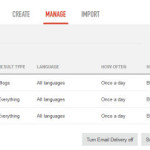We all know that organic traffic generation is one of the more effective ways to attract unlimited and good quality visitors to your site or blog. After all, if your blog ranks well in the search engine results, you’ll see an influx of visitors from search engines looking for some information about your particular niche or business.
Achieving that kind of ranking on the major search engines used to be based on choosing your keywords, tweaking your on-page SEO and getting plenty of quality backlinks pointing to your site.
The Result?
Now, this gave rise to far too many ‘content farms’ swiping those high-ranking positions in the search results. These are the sites filled with barely legible content that is over-stuffed with keywords just to get a decent position on those search engine results.
And people searching for real information and valuable content about different topics don’t like these spammy sites. So, Google decided it was time to do something about this, to encourage and reward quality content and to make their searchers happy.
They’ve recently changed the rules a bit about how the ranking algorithms work in an effort to get rid of those useless sites and replace them with authority sites instead.
Google’s Changes To Organic Search – Facts and Figures
According to Sistrix, larger content farms such as Suite101 lost as much as 94% of their previous visibility on the search engine results. When checked on Alexa.com, Suite101’s traffic numbers had also dropped by more than 19% since those new rules came into effect.

As you can see from above, even the prominent article directories frequented by article marketers have suffered, with EzineArticles losing 90% and ArticlesBase losing 94% of their previous high-visibility status.
Yet when you compare these results to those of eHow since those changes, you soon notice that eHow actually gained more visibility and increased in ranking for thousands of keywords across the site. This is Google’s way of rewarding those sites and blogs containing high quality, well-researched, unique content that offers value to visitors searching for real information.
So, what does this mean to you? How do you deal with Google’s new changes and still be able to grab high search engine rankings?
Here are some effective ways that you can implement to beat the new Google ranking algorithms and attract more high quality organic visitors to your blog:
1. Content Really IS King
I know, I know – you’ve probably heard this cliché 1001 times, but it is so true. It all starts with great and quality content. What’s the point in generating traffic to your site if your content sucks?
Most webmasters already know the importance of having good quality content on their blogs. People who visit your blog expect some kind of helpful, useful, enlightening and entertaining content about the topic they were searching for, so be sure you give it to them.
This means spending a bit of time researching your choice of keywords and then delivering the goods on the information you provide.
Just be sure your content doesn’t go stale. Google still tends to give preferential rankings to those blogs with fresh, unique content that is updated regularly. It is important to have a blogging schedule that you can stick to so that you can produce new content at least 3 times a week.
2. Make Your Blog Sticky

With the changes to the way Google works out search engine rankings, it’s no longer enough to throw a few keywords around your posts and get a few backlinks happening. Google is now looking closely at other factors relating to visitor activity on your blog.
These include monitoring time-on-site and pages visited on your site.
So it’s not enough to generate traffic to your blog, sign them up on your opt-in form or page and then send them on their way. You need to make your blog sticky enough that visitors will want to hang around and read what you have to say.
You’ll also want to encourage them to dig deeper into your content archives and see what else they can learn from you while they’re already there.
Not only does this keep those people on your site longer, but it also increases your page views at the same time. These are both about to become important considerations for how Google views your site, so keep them in mind.
3. Deep or Internal Linking
One effective way to encourage readers to learn more information is to add deep-links to your content. Deep linking is simply linking to another page on your blog from the current post you’re writing.
Not only does deep linking encourage your visitors to click deeper into your site to find out more, but it also has the double benefit of helping the Google spiders to index more pages from your site more easily.
The next time you create a new post, think about how many related posts you may have written in the past that could enhance that topic and link to them using anchor text for your keyword(s).
4. Search Engine Optimization (SEO) IS Imperative

Traffic generation from search engines in the first place still relies on getting your SEO tactics right.
This means checking your title, your tags and your content for inclusion of the right keywords.
It should also mean keeping your keyword density at reasonable levels so those search engines don’t misinterpret them as being spammy.
A general rule of thumb should be that your primary keywords or key-phrases should be at around 1.5%-2% of the total content amount.
Search engines are also very aware of the value of Latent Semantic Indexing (LSI), so you can give your existing keywords a bit of a boost by adding some synonyms for your chosen keywords.
Not only will this make your content more readable in the eyes of your visitors, but it will help to keep your rankings at high levels in the long run.
5. Promote Your Content
Of course creating amazing content is not the only thing you need to do to improve your search rankings and traffic generation.
You need to boost your SEO efforts by promoting your content to put it in front of as many eyeballs as possible. Social media is red HOT right now and it offers free “word of mouth” advertising. Take advantage of that and create a buzz on your blog.
The more people share your content on the social media sites, the more it will get massive exposure and the more quality backlinks you will create.
Creating a lot of Twitter and Facebook backlinks will help you to increase your rankings since Google added these social media sites to their algorithm and use them in their rankings.
Next, let’s take a look at Article Marketing…
What’s the Verdict For Article Marketers?
Before the new Google algorithm was released, most traffic generation tips focused heavily on the benefits of article marketing. This really did give blog owners a great way to generate traffic quickly by submitting dozens of low quality articles to the article directories and linking them back to their primary blog or website.
Unfortunately, it appears the rules for article marketers will now have to change to suit these changes.
While there has been a spate of bloggers pointing out that article marketing is about to die a quick and painful death as a result, this doesn’t have to happen. In fact, it seems quite logical that if Google is rewarding well-researched, unique content, it stands to reason that they’ll reward those marketers who comply with this.
I think article marketers should consider taking more time to create better quality articles before submitting any old garbage en mass to as many directories as they can find.
This could mean rewriting original content prior to submitting it to different directories. It could also mean being more selective with the directories you choose to use.
Key Takeaway
I’m sure that you’ll agree with me that you need good quality and properly optimized content to generate an influx of organic traffic to your blog.
You’d be turning your own site into an “authority site” that Google is more likely to view favourably, especially since the new algorithm makes it very clear that the site with the best content for a given keyword will be the one rewarded.
So, what do you think of Google’s new changes and what’s your plan of action? Please leave me a comment below to share your thoughts.

This article is part of the Traffic Generation Blogging Contest, please add a comment and share it to support the author.









Comments are closed.